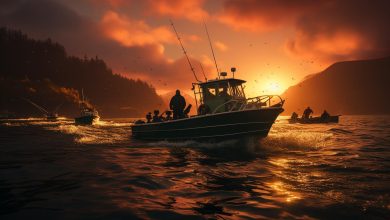Matching The Hatch Understanding Insect Life Cycles For Effective Fly Selection
You might think that fly fishing is all about the equipment, technique, and skill of the angler. But in reality, one of the most important aspects of successful fly fishing is understanding the insects that fish feed on and selecting the right fly to match their hatch.
It’s ironic that while we spend so much time perfecting our casts and tying intricate flies, it’s often a simple matter of matching the right insect at the right time that can make or break a day on the water.
Understanding insect life cycles is essential for effective fly selection. Different species of insects have unique lifecycles, from egg to larva to pupa to adult. Knowing when each stage occurs and how long it lasts can give you insight into what kind of insect fish are feeding on at any given time.
This knowledge can help you choose a fly pattern that mimics exactly what fish are looking for, increasing your chances of success on the water.
The Importance of Matching the Hatch in Fly Fishing
You won’t catch a thing if you don’t know what the fish are eating, so it’s crucial to study the timing and behavior of local aquatic insects. Fly selection techniques and fly fishing strategies require a keen understanding of insect life cycles.
The phrase ‘matching the hatch’ refers to selecting flies that mimic the insects currently hatching in the water. This means that you need to pay attention to everything from water temperature to weather patterns.
Different insects have different life cycles, so you’ll need to be familiar with each species’ egg-laying habits, nymph stages, emergence times, and mating behaviors. While it may seem overwhelming at first, taking the time to learn about insect biology will ultimately help you become a better angler.
Understanding which stage of an insect’s life cycle is most appealing to fish can make all the difference in whether or not they take your fly.
Understanding Insect Life Cycles
So, you want to understand the intricacies of insect life cycles when it comes to fly fishing? Well, let’s dive right in.
Firstly, it’s important to know about the different types of aquatic insects that fish feed on and how their life stages vary from species to species.
Secondly, understanding the various phases of an insect’s life cycle is crucial for selecting the right fly patterns at the right time.
Lastly, weather and water conditions significantly influence insect hatches and ultimately determine what flies will be successful on a given day.
Different Types of Aquatic Insects
Well, look who’s joining us for a swim – the creepy crawlies of the underwater world! Let’s take a dive into the various types of bugs that call our rivers and streams home.
When it comes to fly patterns and trout feeding, it’s essential to understand the different types of aquatic insects. Mayflies, caddisflies, stoneflies, midges – these are just some of the many species you’ll encounter while fishing.
Mayflies are common in most bodies of water and have a short lifespan as adults but can spend up to two years in their nymph stage. Caddisflies are also prevalent and come in various sizes and colors – from dark greens to bright oranges. Stoneflies prefer cold water temperatures and can be found in fast-moving streams or rocky riverbeds. Lastly, midges are tiny insects often mistaken for mosquitoes but lack the annoying bite.
Understanding these different types of aquatic insects is crucial when matching your fly selection with what fish are feeding on at any given time.
As we now have an understanding of the various types of bugs that inhabit our waters, let’s move onto discussing their life stages before they become fully matured adults.
Life Stages of Insects
Let’s dive into the fascinating world of insect development and explore how these tiny creatures transform from eggs to larvae, pupae, and finally emerge as fully grown adults.
Insect metamorphosis can be classified into two types: incomplete metamorphosis and complete metamorphosis. Incomplete metamorphosis is characterized by three stages – egg, nymph, and adult. The nymphal stage is similar to the adult stage but lacks reproductive organs.
On the other hand, complete metamorphosis has four stages – egg, larva, pupa, and adult. Knowing the life stages of insects is essential in fly selection because different stages have different feeding habits.
Larvae are active feeders that consume a considerable amount of food compared to other stages. Pupae are relatively inactive but still require nutrients for their growth and development towards adulthood. Adult insects mainly feed on nectar or other sugary substances for energy to fly around and mate with their counterparts.
Understanding insect feeding habits helps anglers select flies that closely mimic their natural prey at each developmental stage. In conclusion, understanding insect metamorphosis and feeding habits is crucial in selecting an appropriate fly pattern that mimics natural prey during fishing trips.
Next up on our discussion will be exploring how weather and water conditions affect insect hatches – an important factor in successful fly fishing!
How Weather and Water Conditions Affect Insect Hatches
You’ll want to pay close attention to the weather and water conditions because they play a crucial role in determining when and where insects will hatch, ultimately influencing your chances of catching fish on the fly.
Seasonal patterns have a significant impact on fish behavior, as changes in temperature and rainfall affect insect life cycles. For example, during springtime when water temperatures are rising, you can expect to see more mayfly hatches as nymphs start emerging from their aquatic homes.
In addition to seasonal patterns, water conditions also play a big role in insect hatches. Heavy rainfall can wash away larvae or disrupt egg-laying habits of adult insects, while droughts can dry up streams and reduce the amount of available food for fish.
Understanding how these factors interact with each other is key in selecting the right fly pattern that mimics the natural prey available at any given time. Transitioning into the next section about choosing the right fly pattern is important because it ties together how knowledge of insect life cycles and environmental conditions ultimately lead to successful fishing on the fly.
Choosing the Right Fly Pattern
Picking the perfect fly can be a challenge, but with some knowledge and experimentation, you’ll be able to find the right one for the job.
When it comes to choosing the right fly pattern, there are a few things to keep in mind. Firstly, consider the insect species that is currently hatching and match your fly pattern accordingly. Look closely at the size, shape, and color of the insects in order to select a fly that closely resembles them.
Secondly, pay attention to tying techniques and materials used when selecting your fly patterns. Different tying techniques will create different effects on your flies which will determine how they move through water. Additionally, certain materials may imitate specific stages of an insect’s life cycle better than others. Experimenting with different patterns will help you determine which ones work best for different conditions and situations.
By taking these factors into consideration when selecting your flies, you increase your chances of success on the water.
As you get more comfortable matching hatch patterns and experimenting with various tying techniques and fly fishing gear selections, there are other tips that can help make your experience even more fruitful.
Tips for Successful Fly Fishing
Now that you know how to choose the right fly pattern, it’s time to focus on some tips for successful fly fishing.
One of the most important aspects of fly fishing is fly selection. To effectively match the hatch, you need to understand insect life cycles and have a variety of flies in your arsenal.
When selecting a fly, make sure to observe the water and take note of any insects or baitfish present. You can also consult with local experts or do research on what types of insects are common in the area you plan to fish.
Additionally, casting techniques play a crucial role in successful fly fishing. Practice your cast before hitting the water and try different techniques until you find what works best for you. Remember to be patient and persistent – sometimes it takes several tries before getting that perfect catch.
With these tips in mind, you’ll be well on your way to becoming a skilled fly fisherman. But there’s still one more important aspect to cover: matching the hatch.
Conclusion: The Art of Matching the Hatch
It’s time to dive into the art of figuring out what the fish are eating and using that knowledge to catch them in a way that feels like magic.
This is where matching the hatch comes in. Mastering fly fishing techniques requires an understanding of insect life cycles, as different insects emerge at different times of year, and even within a day.
When you can identify which insects are present, you can choose the right fly pattern and size for effective fly presentation. To be successful at matching the hatch, it’s important to observe the water closely.
Look for any signs of insect activity such as rising fish or swarms of bugs on the surface. Once you’ve identified what type of insect is hatching, take note of its size, color, and behavior.
Match these characteristics with a corresponding fly pattern from your collection. Present your chosen fly delicately and naturally by mimicking how an actual insect would move on or beneath the water’s surface.
When done correctly, this technique will increase your chances of catching more fish while adding a level of satisfaction to your experience as an angler.
Conclusion
Congratulations! You’ve now learned the art of matching the hatch in fly fishing. By understanding insect life cycles and choosing the right fly pattern, you’re well on your way to becoming a successful angler.
Remember, always observe your surroundings and take note of any hatching insects. Use this knowledge to select the appropriate fly pattern that best imitates the natural insect.
With practice and patience, you’ll be able to catch more fish than ever before. So go forth with confidence, armed with your new knowledge and skills.
And don’t forget to enjoy the beauty of nature while you’re out on the water. Happy fishing!


